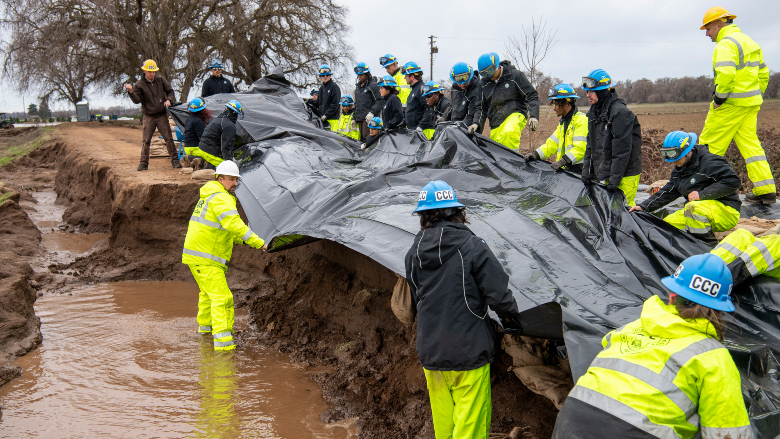A series of severe winter storms has caused flooding, mudslides and power outages in parts of California, resulting in 14 deaths in the past week and an undetermined amount of damage. In response to a request by Gov. Gavin Newsom, President Joe Biden approved an emergency declaration in a 17-county area. Forecasters say more storms are still on the way.
The California Dept. of Water Resources activated its flood operations center with round-the-clock monitoring Jan. 3. Jeremy Arrich, manager of DWR’s flood management division, says the agency is focused on Pajaro River in Santa Cruz and Monterey counties, Salinas River in San Luis Obispo and Monterey counties, Cosumnes River in Sacramento County, Bear Creek in Merced County and Russian River in Mendocino and Sonoma counties. Seven locations are forecast to exceed flood stage within the next five days, and 20 more are expected to exceed monitor stage, which can result in overflow from weirs into bypass areas.
Four of the six weirs on the Sacramento River flood control system are flowing as designed, Arrich says, bur officials do not expect to open the Sacramento weir. The flood operations center has deployed material in 16 counties, which includes more than 389,000 sandbags, 3,000 ft of reinforcing muscle-wall and 500,000 sq ft of plastic sheeting for levee protection.
While first responders work to keep people safe from the current storms, the deluge has sharpened concerns about the state's flood resilience. A proposed state budget Newsom introduced Jan. 10 includes $202 million in new investments for flood prevention projects under the state’s 2040 water plan that officials shared last August.
“There is a vision and there’s a strategy,” Newsom said during a press conference. “We recognize the urgency of the moment to implement and to make sure that we're prepared not just for this week in the storms, not just for the next year or two, but for decades to come.”
The projects would modernize water diversion and conveyance infrastructure, and would better capture stormwater to alleviate California’s ongoing drought woes, he said.
Nearly all of California remains in a drought, according to the latest U.S. Drought Monitor update. With the state simultaneously experiencing a drought emergency and a flood emergency, DWR Director Karla Nemeth said it is “yet another” signal of the effects of climate change.
From 2030 to 2040, California officials aim to double stormwater capture to 500,000 acre-ft. The water plan also calls for increased water recycling, desalinated water production and water storage.
The $202 million for flood projects includes about $135 million for urban flood risk reduction projects, $40 million for projects to strengthen Delta region levees and $25 million for floor protection of Central Valley communities, said California Natural Resources Secretary Wade Crowfoot.
The Continuing Deluge
State and local officials are preparing for additional storm systems over the next few weeks. As of Jan. 10, six of the series of nine storms expected to impact California had reached the state, state climatologist Michael Anderson says. Streams and rivers are still rising, although he notes some have peaked.
As of Jan. 10, more than 150,000 customers were without power across California, according to poweroutage.us, a website that works with utilities to track outages. That figure was down from earlier in the day. Teresa Alvarado, vice president of PG&E’s South Bay and Central Coast region, said in a video on the utility’s website that it had “mobilized its largest storm response effort in company history” and restored power to 1.6 million customers since the New Year’s Eve weekend storm.
Caltrans, the California Dept. of Transportation, reports numerous weather-related road closures around the state. The agency shared dramatic videos online of roads covered in fast-moving water boulders crashing down a hillside, blocking State Route 168 in Fresno County. In Montecito, firefighters said a washed out local road would require “a long term repair project.” A portion of I-80 between Truckee and the Nevada state line was closed due to whiteout conditions.
Agency Deputy Director Mike Keever said it has 4,000 maintenance crews working to keep roads open. “We’re doing everything we can to keep the roadways open, but safety is and will remain our No. 1 priority,” he says.





